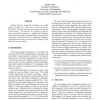Free Online Productivity Tools
i2Speak
i2Symbol
i2OCR
iTex2Img
iWeb2Print
iWeb2Shot
i2Type
iPdf2Split
iPdf2Merge
i2Bopomofo
i2Arabic
i2Style
i2Image
i2PDF
iLatex2Rtf
Sci2ools
ICSE
2009
IEEE-ACM
2009
IEEE-ACM
Configuration and adaptation of binary software components
Existing black-box adaptation techniques are insufficiently powerful for a large class of real-world tasks. Meanwhile, white-box techniques are language-specificand overly invasive. We argue for the inclusion of specialpurpose adaptation features in a configuration language, and outline the benefits of targetting binary representations of software. We introduce Cake, a configuration language with adaptation features, and show how its design is being shaped by two case studies.
Black-box Adaptation Techniques | Configuration Language | ICSE 2009 | Software Engineering | White-box Techniques |
Related Content
| Added | 19 Feb 2011 |
| Updated | 19 Feb 2011 |
| Type | Journal |
| Year | 2009 |
| Where | ICSE |
| Authors | Stephen Kell |
Comments (0)

